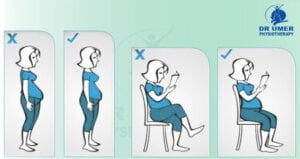The Role of Physiotherapy in Pregnancy is very important. Physiotherapist helps to increase the mobility of joint. Physical exercise helps you to increase the range of motion and strengthening your muscles. It also prevents you from pain and spinal injuries.
Posture Management
There are natural curves to our spines, the spine dips in at the neck out around the chest and then in again in the lower back area.
During pregnancy the weight of the growing baby can sometimes exaggerate. As your tummy grows it pull your center of gravity forwards. It is important that try to pull your tummy muscles back and prevent your lower back from dipping forwards too much. Similarly with your thoracic spine or the middle part of your back around your chest and shoulders, there is a tendency to hunch your shoulders forwards and curve your spine. As your breasts grows can cause pain in the shoulders, spine and chest.
The key is to keep your shoulders back in line with your ears and bring your shoulder blades down and back together. Role of Physiotherapy in Pregnancy is very important for correcting posture.

Correcting your Standing Posture
Bring your shoulders down and back, lifting up the ribcage and pushing gently your chest forwards. Tuck your bottom in and gently pulling in your lower abdominal tummy muscles. Relax your knee joint and divide the body weight over both your feet.
Correcting your Sitting Posture
Sit upright with your bottom touching the back of the chair. You also try sitting with a back support. Keep your body weight throughout both your hips.
Standing and Sitting in any position even if, it is a good posture cause discomfort in the back. So, avoid standing and sitting in the same position for too long. Change your posture every 30 minutes.
Sleeping Position
Sleep on side with keeping a pillow between your knees. Sleeping on side helps to stay your lower back in neutral position.
Benefits of Physical Therapy
- Reduce fatigue
- Strengthen muscles (improves support for back & pelvis)
- Reduce swelling in hands and legs
- Reduce stress, anxiety and depression
Exercises
- Lie down on the floor with pillow. Raise the both hands up to the roof then take your hands towards the floor with holding the breath. Now, breath-out and relax your hands by your side.
- Lie down flat on the floor. Bring the both knees and feet together. Turn your knees on one side with turning your head on the other side. Hold it for 3 seconds. Relax and turn your knees to other side with turning your head on other side. Repeat 10 times.
- Lie down flat on the floor. Bring the both knees and feet together. Place a pillow between your knees. Pull up your hip towards the roof and hold it for five seconds. Relax and return back to the starting position. Repeat 10 times.
- Lie on your side with pillow under your head. Take your hands (flat and straight) and knees directly in front of you. Raise-up your one hand to the roof with your eyes and hold it for three seconds. Relax and come back starting position. Repeat 10 times.
- Sit with straight back on the floor. Bend your knees. Keep the soles of your feet together. Make sure your knees pointing in opposite direction. Raise your knees and then press with elbow down again. Repeat 10 to 15 times. On your hands and knees make sure that your knees are hip-width apart and your arms are under your shoulders. Spine should be in a straight line and now slowly arch your back and look up at the roof. Hold it for 3 seconds. Then round out your upper back and look down. Hold it for 3 seconds. Repeat 10 times.


